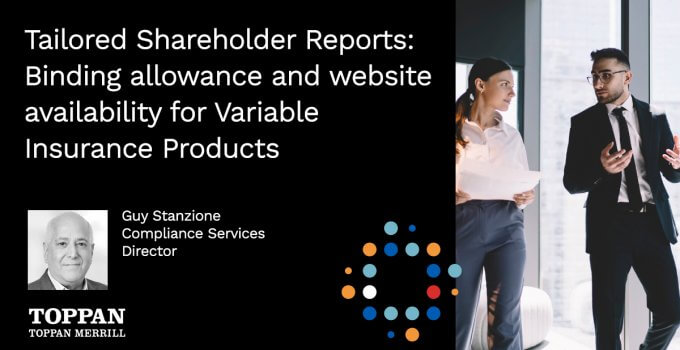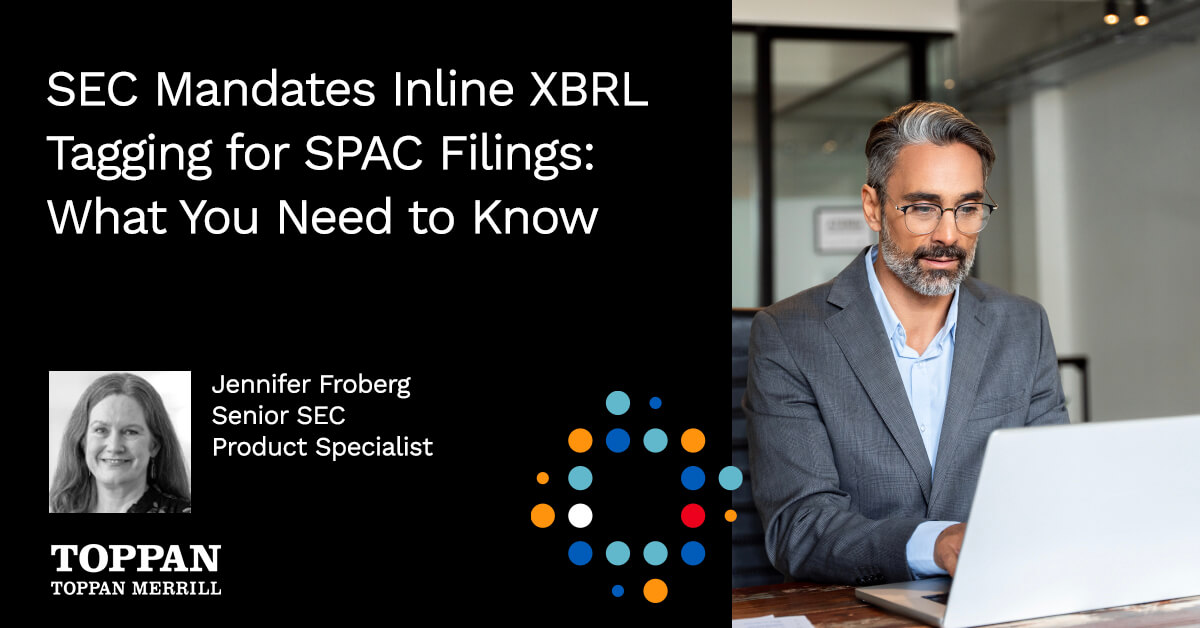On Friday, January 19, 2024, SEC staff of the Division of Investment Management published “Frequently Asked Questions” related to Tailored Shareholder Reports (TSR).
To include responses to additional questions, the staff may update this information from time to time. The release of the FAQs was timely based on the upcoming compliance date of July 24, 2024. The responses represent the staff views of the Division of Investment Management and are not rules, regulations or statements of the Commission.
Although the Commission has neither approved nor disapproved the answers to these FAQs, they provide guidance for issues raised since the October 2022 adoption of the rule and form amendments.
The two areas of discussion most relevant to variable product issuers are:
- The binding allowance for multiple shareholder reports into a single book
- The website availability of underlying fund documents.
1. Binding Individual Shareholder Reports of Multiple Funds
In the FAQ, the SEC provided guidance, allowing individual TSRs to be bound together into a single book. The permission for issuers to bind individual reports into a single book provides a huge operational and cost benefit to issuers who choose to take advantage of the Staff’s permissive guidance. As importantly, the allowance also provides a better user experience for contract owners by reducing the number of documents received in the mail. Minimizing the number of individual self-mailers and/or the documents inserted into an envelope enhances the client experience, consistent with the binding allowance for mutual fund Summary Prospectus Rule 498. Client advocacy was viewed as an extremely important factor in our discussions with SEC staff.
Following the precedent set in Rule 498, this allowance aligns with the document delivery model in place since 2009.
Unlike Rule 498, which provides the binding allowance for underlying fund Summary Prospectus for variable products only, the TSR binding allowance extends to TSRs for all fund types and is not specific to variable products. However, the greatest application and benefit is in the variable product space and created a “huge win” for issuers and contract owners.
Similar to the Summary Prospectus guideline, the SEC suggests the fund or variable product issuer should consider including a table of contents to any bound, stapled, or stitched shareholder reports for increased investors’ ease of use.
The benefits realized through cost savings, manufacturing, technology, and operational efficiencies align with the Commission’s goal to improve investor experience. In addition, following the Summary Prospectus delivery model provides a consistent user experience.
2. Website Availability Requirements
The FAQ discusses the online presentation of content contained in Form N-CSR needed to satisfy the requirements of Rule 30e-1(b) of the ‘40 Act. The adopting release specifies funds have the option to satisfy the website availability requirement for the information filed on Form N-CSR by posting the entire N-CSR on the website specified in the shareholder report. Although the SEC allows for the posting of the entire N-CSR, the rule only requires Items 7 to 11 from the N-CSR to be posted.
The online presentation may be grouped by type of materials and/or by series so long as this information meets certain presentation requirements, and the grouped information:
- Is presented in a format designed to effectively communicate the information.
- Clearly distinguishes the different types of materials and/or each series, as applicable.
- Provides a means of easily locating the relevant information, including, for example, a table of contents that includes hyperlinks to the specified materials and series.
When funds submit combined Form N-CSR filings that include multiple series, the release states that information contained in the Form N-CSR filings will also need to meet these website presentation requirements. The staff believes that a combined response to multiple Form N-CSR items would generally be appropriate if the combined response satisfies the three requirements for grouped information in the context of website availability obligations.
Rule 30e-1 states, to satisfy its obligations under section 30(e), a fund must make certain materials publicly accessible, free of charge, at the website address specified at the beginning of its shareholder report. Along with the N-CSR items, the SEC will require the Annual Report and Semi-Annual Report (TSRs) to be web posted at the share class level, utilizing the layered disclosure framework initially introduced in Rule 498 for mutual fund Summary Prospectuses.
Other questions frequently raised relate to the web hosting requirement for variable product issuers.
For example:
- “When the requirement applies to a variable annuity or variable life insurance company issuer, where should the required materials for funds that are investment options underlying the variable contract (“underlying funds”) be made available?”
- “Should the required underlying fund materials appear on the variable contract issuer’s website or the fund’s website?”
The staff responded that the materials could appear either on the variable contract issuer’s website or the fund’s website. Neither rule 30e-1 nor Form N-1A includes express requirements regarding the entity that must host the required fund materials. The staff recognizes as a practical matter, if multiple variable contract issuers permit contract value to be allocated to the same underlying fund, it may be more efficient for the required fund materials to appear on the underlying fund’s website as opposed to the variable contract issuers’ websites. For example, if the fund materials were to appear on the websites of Issuers A, B, and C, this would effectively require the beginning of the underlying fund’s shareholder report to list multiple websites instead of only listing the underlying fund’s website and multiple websites would be required to host materials for the same underlying fund.
Although the SEC’s response in the FAQ regarding the websites where documents can be hosted is not restrictive and provides flexibility, contract owner user experience must be considered. Hosting the underlying fund documents on the variable product issuer’s website minimizes the number of websites a contract owner would need to search for their fund documents.
Many product issuers host fund documents to “keep contract owner anchored” to their website as opposed to sending them elsewhere for information that can be easily made accessible on their website. Along with user experience and the number of funds available for investment as part of a contract, variable product issuers should consider this as a preferred business practice.
Although conversations with SEC staff have specified that if a variable product utilizes Rule 498A for their prospectus delivery and only makes the underlying fund Summary Prospectuses available online, the annual and semi-annual TSRs must also be posted to the variable product’s website. Many variable product issuers have expressed the desire to continue to host the additional fund documents on their website, specifically the content in the fund’s Form N-CSR. These decisions are based on the user experience, client advocacy and somewhat ambiguous interpretive directions from the SEC are factors mentioned during our discussions.
View the full FAQ on the SEC’s website: https://www.sec.gov/investment/tailored-shareholder-reports-faqs
How Toppan Merrill can help
Toppan Merrill has been helping funds and variable product issuers with their required financial reporting and compliance requirements for decades. We continually monitor the SEC modernization updates and help with formatting, inline XBRL and website display architecture for the new Tailored Shareholder Report requirements. Our experts are in constant contact with the SEC to clarify rules and ensure our clients are in full compliance.
We offer simple and straightforward solutions that help you bring your filing and reporting into compliance. If you have any questions about the Tailored Shareholder Report Rule, client communications systems, or other matters concerning the 1940 Securities Act, the experts at Toppan Merrill can help. Connect with us or phone at 800.688.4400.



